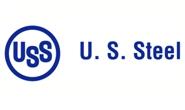Steel Mills

Weather Major Factor for US Steel
Written by Sandy Williams
April 30, 2014
“We weathered not only the economic storm with five years of losses but also the first quarter’s extreme weather,” was one of the opening remarks by Executive Vice President & CFO David Burritt in the US Steel Conference Call on Thursday.
Weather played a huge part in operations at US Steel in the first quarter. President & CEO Mario Longhi told analysts on the call that “ice conditions in the Great Lakes and, particularly, Lake Superior are the worst we have seen in 30 years.” Normally shipping is on hold in winter for around 70 days but this year shipping was held up over 120 days and ice cutters are still assisting vessels across Lake Superior.
“As a result of the difficulty moving pellets from our mines to our plant, we are managing our steel production in line with our available pellet inventories, said Longhi. “We have also been challenged in our ability to make certain products due to an unplanned outage at the steel shop at our Great Lake Works. We’re working to complete repairs and we expect to resume steel making operation at the Great Lake Works by the middle of May.”
Longhi said the shipment of ore is still at a slow pace. Rather than “crank the capacity” up and down as ore comes in US steel is working to be “careful and provide a steady flow, keep the operations in control and then get to the end of the quarter at a very sustainable pace.”
In an interesting anecdotal remark, Longhi said two vessels had been pierced by icebergs and will a need at least a week to repair.
Dan Lesnak, general manager-investor relations, said with increased efficiency US Steel will be able to offset some of the costs from recent incidents at Gary Works and Great Lakes. No figures were available on costs from production disruptions and logistic issues.
However, Mario Longhi provided the following in his prepared remarks, “Now turning to our outlook for the second quarter, we expect reduced income from operations in the second quarter. Our production will be limited, which will temporarily slow shipments primarily due to continued weather-related logistical issues effecting both raw materials and finished goods. We expect to report a loss for our Flat-Rolled segment in the second quarter as these operational difficulties have limited our production, resulting in lower shipments and higher operating costs as compared to the first quarter.
“Although market conditions in North America are improving, average realized prices should be comparable to the first quarter. Given our production disruptions second quarter shipments will be geared to fulfilling contract commitments where prices are not moving at the same rate as the spot market as well as negatively influenced by lower automotive coated production and shipments in this quarter while we do believe that our operational difficulties will be behind us as we exit the second quarter.”
On the issue of aluminum use in the auto industry, Longhi said “We take these alternative threats very seriously.” US Steel is working on Generation 3 advanced steel solutions for the auto industry that will replace plain carbon steels to reduce weight with safer, lighter steels.
Commented Longhi, “The ultimate solution we will take to our automotive customers will be a very enhancing, formable, joinable, paintable solution that our customers are familiar with. That’s the steel. And it will also be a safer, less expensive solution that is much more familiar to the end users and the repair facilities in the event repairs are needed. So we see these challenges from other materials as real but believe that we have and are still creating steel solutions that will deliver even more value to the automobile manufacturers and their customers.”
A lot of discussion was devoted to the Carnegie Way in practice at US Steel (mentioned 28 times, in fact). Carnegie Way savings have realized $140 million in first quarter, bringing the total so far to $290 million. Cash and liquidity at the end of first quarter totaled $2.7 billion. Cash that will be used for high return projects, both internal and M&A. Burritt said deployment of cash for growth projects could include anything. “You never know what comes around. We just feel like we need to keep our eye on cash generation, be prepared.” US Steel management was not ready to discuss and specific potential acquisitions.
Longhi was reluctant to provide a price forecast for the coming quarter saying it will depend on supply conditions and mini cycles. “It’s really hard to you give you a figure there. It’s going to bounce up and down.” US Steel does plan on concentrating more on contracts in the second quarter rather than spot prices.
Correction: Tuesday evening USS article on their earnings showed operating income as sales in error. The correction reads as follows:
Flat rolled steel sales operating income in first quarter dropped to $85 million from $87 million in Q4 2013; US Steel Europe income was $32 million, up from $12 million quarter over quarter; tubular income fell to $24 million from 32 million the previous quarter. Higher contract and spot prices increased the average realized price of flat rolled to $761/net ton.

Sandy Williams
Read more from Sandy WilliamsLatest in Steel Mills

Nucor lowers 2024 output estimate for Brandenburg plate mill
Nucor has lowered the 2024 production estimate for its Brandenburg, Ky., plate mill due to soft market conditions.

SSAB adjusts output in weak Q3, readies for Q4 rebound
SSAB said lower plate prices in the US were the primary reason for reduced results in the second quarter. With a dismal Q3 outlook, the Swedish steelmaker is adjusting production across its facilities. That includes moving up its annual US mill outage in anticipation of a better Q4. SSAB Americas Revenues in the Americas segment […]

Topalian puts focus on “unfair” trade, eyes USMCA partners
Nucor’s top executive expressed concerns over unfair trade practices, highlighting increased steel imports from Mexico and Canada.

Cliffs sees close of Stelco buy, bottom to steel tags, and Mexico out of USMCA
Cleveland-Cliffs expects its acquisition of Canada’s Stelco to close later this year, which will help the the Cleveland-based steelmaker as a bottom to steel tags nears.

Nucor posts lower Q2 earnings, predicts tough Q3 too
Nucor recording lower second quarter earnings on falling steel prices. And the Charlotte, N.C.-based predicted that profits would be lower still in the third quarter, primarily because of weaker results from its steel mills divisions.
